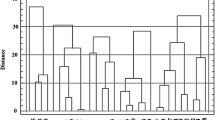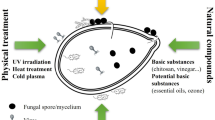Abstract
Volunteer oilseed rape is a relevant weed in many crop rotations due to seed persistence and dormancy. With the intro-duction of imidazolinone-tolerant oilseed rape varieties in Europe, herbicide-based control strategies of volunteers in cereals may become ineffective in the future. Experiments were conducted on experimental fields and in outdoor pots in Bingen (Germany) to quantify the effect of oilseed rape volunteers on yield and quality parameters of wheat. To simulate competition, oilseed rape was sown into wheat plots at a range of 2 to 320 plants m−2. Both spring and winter varieties of oilseed rape and wheat were used in the experiments. Crop yield parameter were expressed as the number of heads m−2, net yield as kg ha−1 and hectolitre−1 weight. Wheat moisture content, percentage of dockage, wheat thousand-kernel weight, and crude protein content were determined. Significant negative correlations were detected between the yield parameters heads m−2 and yield on the one hand, and oilseed rape density on the other hand. Moisture content of wheat and percentage of dockage were positively correlated with the volunteer density. No clear correlation was found between volunteer oilseed rape density and thousand-kernel weight, hectolitre weight and crude protein content of wheat. The highest volunteer density of 261 plants m−2 caused a maximum yield loss of 68% in winter wheat. Based on a non-linear regression analysis, a single volunteer oilseed rape plant m−2 is able to cause a yield loss of 0.74 to 1.61% in the field, which corresponds to 26.3 kg ha−1 (spring oilseed rape in spring wheat (SOSR × SW)) and 147.3 kg ha−1 (winter oilseed rape in winter wheat (WOSR×WW)), respectively. However, the introduction of imidazolinone-tolerant oilseed rape varieties will challenge farmers in terms of volunteer management. Control of volunteers is important to reduce yield losses. Accurate, delayed tillage after oilseed rape harvest and control of imidazolinone-tolerant volunteers with herbicides with other modes of action than those grouped into HRAC B will contribute to the successful avoidance and removal of imidazolinone-tolerant volunteers from subsequent crops.
Similar content being viewed by others
References
Beckie HJ, Seguin-Swartz G, Nair H, Warwick SI & Johnson E, 2004. Multiple herbicide-resistant canola can be controlled by alternative herbicides. Weed Sci 52, 152–157.
Brain P, Wilson BJ, Wright KJ, Seavers GP & Caseley JC, 1999. Modelling the effect of crop and weed on herbicide efficacy in wheat. Weed Res 39, 21–35.
Bremer H, Pfenning M & Kehler R, 2011. The Clearfield® production system in oilseed rape — a new herbicide generation in oilseed rape in Europe. Proceedings of the 13th International Rapeseed Congress, Abstract Book. 61.
Bundesamt für Verbraucherschutz und Lebensmittelsicher-heit (BVL), 2005. Absatz an Pflanzenschutzmitteln in der Bundesrepublik Deutschland — Ergebnisse der Meldung gemäß §19 Pflanzenschutzgesetz. www.bvl.bund.de
Cousens R, 1985. A simple model relating yield loss to weed density. Ann Appl Biol 107, 239–252.
Froud-Williams RJ, 2002. Weed competition. In: Naylor REL (Ed.) 2002: Weed Management Handbook. Blackwell Publishing, Oxford. 16–38.
Gruber S, Pekrun C & Claupein W, 2005. Life cycle and potential gene flow of volunteer oilseed rape in different tillage systems. Weed Res 45, 83–93.
Gruber S & Claupein W, 2008. Emergence and establishment of volunteer oilseed rape in spring and winter crops. J Plant Dis Protect Special Issue XIX, 151–159.
Gruber S, Bühler A, Möhring J & Claupein W, 2010. Sleepers in the soil — vertical distribution and long-term survival of oilseed rape seeds compared with plastic pellets. Eur J Agron 33, 81–88.
Gulden RH, Shirtliffe SJ & Thomas AG, 2003. Harvest losses of canola (Brassica napus) cause large seedbank inputs. Weed Sci 51, 83–86.
Holm LG, Plucknett D, Pancho J & Herberger J, 1977. The world’s worst weeds: distribution and biology. University Press of Hawaii, Honolulu.
Karim SMR, 2000. Competitive ability of volunteer crops grown as weeds. Pak J Agric Res 16, 142–146.
Kim DS, Brain P, Marshall EJP & Caseley JC, 2002. Modelling herbicide dose and weed density effects on crop:weed competition. Weed Res 42, 1–13.
Lawson AN, Acker van RC & Friesen LF, 2006. Emergence timing of volunteer canola in spring wheat fields in Mani-toba. Weed Sci 54, 873–882.
Liu JG, Mahoney KJ, Sikkema PH & Swanton CJ, 2009. The importance of light quality in crop-weed competition. Weed Res 49, 217–224.
Martin SG, Acker van RC and Friesen LF, 2001. Critical period of weed control in spring canola. Weed Sci 49, 326–333.
O’Donovan JT, Harker KN & Dew DA, 2008. Effect of density and time of removal of volunteer canola (Brassica rapa L.) on yield loss of wheat (Triticum aestivum L.). Can J Plant Sci 88, 839–842.
Pallutt B, 1995. Zur Wirtschaftlichkeit des Herbizideinsatzes. Getreide 3, 20–22.
Pekrun C, Lutman PJW & Baeumer K, 1998. Research on Volunteer Rape: a Review. Pflanzenbauwissenschaften 2, 84–90.
Pekrun C, 2004. Einfluss der Bodenbearbeitung auf die Überdauerung von Samen und andere pflanzenbauliche Parameter unter besonderer Berücksichtigung der Populationsdynamik von Ausfallraps. Cuvillier Verlag Göttingen, Göttingen, 161.
Seerey NJ & Shirtliffe SJ, 2010. Commercial generations of Brassica napus cause greater yield loss in Triticum aestivum, than volunteer B. napus generations. Can J Plant Sci 90, 777–783.
Söchting HP, Gummert A & Zwerger P, 2008. Auflaufdynamik und Wachstumsverlauf von Ausfallraps in Winterrapsbeständen. J Plant Dis Protect Special Issue XXI, 303–308.
Tan S, Evans RR, Dahmer ML, Singh BK & Shaner DL, 2005. Imidazolinone-tolerant crops: history, current status and future. Pest Manag Sci 61, 246–257.
Tranel PJ & Wright TR, 2002. Resistance of weeds to ALS- inhibiting herbicides: what have we learned? Weed Sci 50, 700–712.
Wright KJ, Seavers GP, Peters NCB & Marshall MA, 1999. Influence of soil moisture on the competitive ability and seed dormancy of Sinapis arvensis in spring wheat. Weed Res 39, 309–317.
Author information
Authors and Affiliations
Corresponding author
Rights and permissions
About this article
Cite this article
Krato, C., Petersen, J. Competitiveness and yield impact of volunteer oilseed rape (Brassica napus) in winter and spring wheat (Triticum aestivum). J Plant Dis Prot 119, 74–82 (2012). https://doi.org/10.1007/BF03356423
Accepted:
Published:
Issue Date:
DOI: https://doi.org/10.1007/BF03356423




